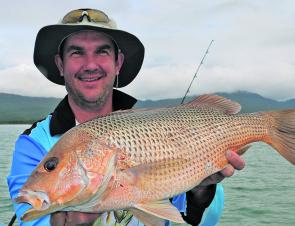Some reports coming from the islands and reefs suggests that we’re in for a good Spanish mackerel season over the coming months.
The next few months should be prime Spanish fishing inshore and I cannot wait to get out there and have a crack at them. Chasing Spaniards is a great alternative to the barra when the colder conditions arrive and the barra become sporadic. I am also looking forward to a bit of a break from charters and the chance to fish some spots up and the down the coast that I like to call ‘wonky holes’. I’ll be fishing these holes largely for reds and trout with plastics, hardbodies and baits and can’t wait to do it. We will be filming much of this for one of our new e-courses.
The reef itself should see some great catches of trout and red throat emperor and some reports from the past month have been encouraging. The reefs off Cardwell and Mission Beach have seen some exceptional catches of red fish, although not everyone is getting them, but those in the know are doing alright. It is usually best to hit the reefs on the making tides for the best results. This applies to most reef species.
If you’re finding barra hard to catch at the moment then maybe try some other species and give the barra schools a break. Fingermark is one such fish that seems to thrive inshore during winter. The trenches between inshore islands, and pinnacles in creeks and rivers will all hold numbers of good size fingermark in the winter. Most fish are around the 1.5-3 kg mark. Other species that frequent the same areas is the black jew, which is a bit of a rare capture in many parts of the east coast, but we do get the odd few around here generally while fishing for fingermark. They are an awesome fish and I would love to see them back in numbers once again. They were a heavily targeted fish in previous decades and that’s why they are a rare capture these days. Northern Australia is the exception, with black jew far more abundant. Hopefully managers will look after the species by introducing some realistic measures to safe guard their numbers.
July should also see a run of grunter as it does most years, particularly either side of the dark moon. Most winter fish in the channel won’t break 2kg, but some of the inner islands will hold some schools of larger fish. Live greenback herring is a great bait for bigger grunter, while squid is also another good bait for these and other species.
The Hinchinbrook channel has also had big schools of small trevally and queenfish. For those who enjoy fishing with light tackle there will be plenty of this kind of action all winter. Just simply look for the terns working the surface and the pelagics wont be far away, especially if you throw a small slice in their direction. Speaking of small slices the northern blues are starting to show around the inner islands, and even inside the northern end of the channel. A small metal slice is all you need and you must track them down and flick the slice into the school while they are smashing bait on the surface. This is about the only way to catch them as just trolling or flicking slices in the vicinity just does not work. I have also had clients flick a soft vibe into the schools with great success too.
Threadfin salmon have been quiet this year with only minimal numbers showing up. They are always better in years after good rains, and with two failed wet seasons in the north, it’s no surprise that they’re in limited numbers. They however should show up in October to December for their spawning period. If you would like to come up for a charter or join our free fishing community head to www.ryanmoodyfishing.com for more info.
Reads: 1201
Matt with a nice early winter barra taken on an Old Dog Lure.

The Bribie barra boys got stuck into some nice fingermark at Hinchinbrook recently.




